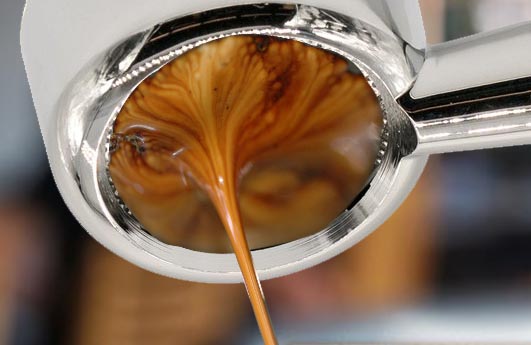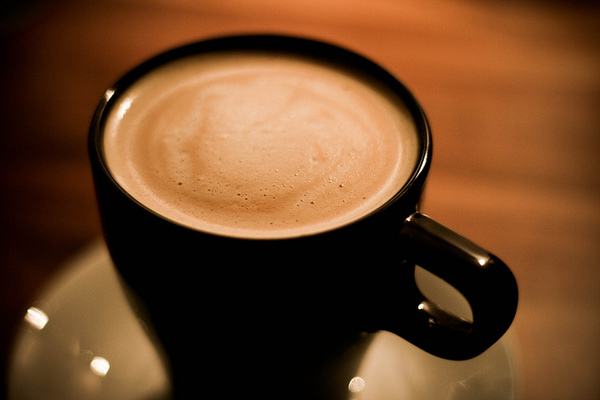You’ve probably seen an image of coffee somewhere, like at the beginning of this article or a coffee shop, that looks absolutely incredible. It looks thick and creamy with an assortment of appealing colors. The coffee just screams at you to drink it! But what exactly is crema in coffee?
Crema definitely makes coffee look appealing. But does it really add the flavor the look of the crema gives off? How can you pull a good crema from you espresso? Let’s dive in and solve all the mysteries and give some tips for what crema can do for you.
What Is Crema In Coffee?

Crema is the tan colored foam that forms on top of coffee as you pull a shot of espresso. After coffee beans are roasted, they begin to release CO2. Most of CO2 is released into the air between roasting and grinding the beans. However, the CO2 that remains is released during grinding. Now let’s move onto what happens as we pull a shot of espresso.
An espresso machine works on pressure. Water is forced through coffee beans placed in a portafilter, and the coffee is aerated. Basically, natural fats and oils from the bean are suspended in micro bubbles of air. This is what gives us our first glimpse of crema during the coffee extraction. That’s where we first begin to see our light tans and browns of crema in coffee.
We then begin to see the part that we all think of when we see crema in coffee. The lighter coffee comes first and then darker coffee is brewed after. The lighter coffee that was pulled from the shot filters back up to the top of the coffee and settles to the top of the shot. Think of it somewhat like what we learned about in school when mixing oil and water. The lighter foamy crema is now settling on top of the darker coffee.
Some people refer to the crema as the “Guinness effect” because it’s similar to the head on a pour of the popular Irish stout. Even an entry-level espresso machine can produce a really good crema. And crema makes the perfect espresso shot and makes the espresso taste good, right? Well not so fast. It’s not so much like the head of a Guinness where it helps make the drink.
Effects Of Crema In Coffee
I think a lot of us, especially, non-coffee connoisseurs are led to believe that a nice looking crema makes or breaks the espresso shot. Among connoisseurs there is actually some debate to the importance of crema in coffee. Because as the industry grew the crema became a symbol for good coffee, but the connoisseurs disagree. Crema because a symbol for two things:
- That the bean’s natural fat/oil content was higher and it could then be assumed to be processed at the plantation in a preferable manner.
- That the coffee had been roasted recently enough that it still had some C02 out-gassing from the beans.
Therefore, baristas became very focused on making a good crema because it represented a good espresso. But that’s not really the case. You can have a great looking crema with terrible tasting espresso, and a bad looking crema where the coffee tastes great.
So at the end of the day, the effects of crema in coffee are minuscule other than it helps make the shot of espresso look good. Now, there may be a psychological impact since we really do eat with our eyes. But in reality crema doesn’t have all that much of an impact on the taste of the espresso.

Good Crema And Bad Crema
Now that we know that the crema doesn’t really effect the taste of coffee it’s still something that you’ll get as you pull your espresso shot. So you still want it to look good, don’t you? Especially, if you’re serving the espresso shot to others who still think that a good crema equates to good flavor.
Good Crema
A good crema should be a nice rich tan color with some reds and gold in it. It should be really smooth and without large bubbles in it. Crema relies on thousands of tiny bubbles to create a foamy, but velvety surface.
The crema should also last for a little while, and it shouldn’t dissipate back into the coffee right away. However, the crema isn’t something that will last your entire coffee. It should last for about two minutes before it dissipates back into the espresso shot. So it’s not too thick that it seems to last forever, and not so thin that it disappears right away. The ideal crema takes up about 1/10 of the espresso shot.
Bad Crema
You might be able to figure out what makes up bad crema based on the good crema. A bad crema is typically a very light tan color. If it’s darker than ideal it’s not much of a problem. But when the crema is a very light tan it can indicate that the water temperature is too low which can lead to a poor tasting espresso.
Another problem you might encounter is large bubbles in the espresso. Also effecting the taste of coffee, this typically happens if the extraction is too fast or if you’re using a light roasted coffee.
Best Espresso Beans For Crema
The best espresso beans are a dark roast bean. Ideally, you’ll also want an espresso bean that was recently roasted but not within the last 72 hours. This is because you want some of the C02 for emulsification of the fat, but not so much that there’s no room for the coffee solids to actually extract. Focus on a coffee that’s been roasted anywhere from two weeks to two months ago.
The two bean options you have are robusta and arabica. Arabica is commonly used worldwide because it’s known to have better flavors and quality. For espresso, robusta is sometimes used because it gives off a better crema but it comes at the expense of taste. This is another reason why connoisseurs would recommend that you forget about the nice looking crema and go for the good taste.
Troubleshooting Bad Crema
| Symptom: Crema a very light tan/yellow color. Extraction took under 15 seconds. ***Note: Light crema can also indicate low water temperature. Cause: Underextraction Solution: Increase extraction time by grinding coffee finer, or tamping harder. Did you use enough coffee? Increase fineness of grind to extend extraction time. Temperature: Check water temperature. Was the machine, the group, the coffee handle all warmed up properly? Is the coffee too fresh? It’s preferable that beans rest for 72 hours after roasting for espresso use. |
| Symptom: Very light tan dot in the middle of extremely dark crema color. Was it more than 10 seconds for the first drops of espresso to appear? Did the espresso come out in drops, never becoming a stream? Did the extraction take over 30 seconds? Cause: Overextraction Solution: Make the grind a little coarser. Back off on the pressure when you tamp the coffee. Did you use too much coffee? ***Note: The range is 7 to 11 grams per single espresso. |
| Symptom: Espresso had great crema color but visibly dropped 1/4 inch or more in the cup as it sat for the first minute. Surface of the espresso marked by very large, unstable bubbles in the crema. Pale Crema Cause: Fast Extraction or Light Roast. Solution: Could be a combination of short extraction and lighter roast. You will also get a less persistent crema if you use robusta in your blend. You have more crema perhaps but it fades sooner. |
| Symptom: Crema has a rich dark color of tightly compacted foam. Crema has darker striations producing a “tiger skin” effect. Cause: Not A Problem Solution: Some might consider this overextracted, but otherwise the flavor will be good. |
| Symptom: Thin crema with large oil globules. Espresso takes a really long time to produce 1 oz of liquid. Espresso comes out of the coffee handle one drop at a time? Cause: Way overextracted. Grind is too fine. Compacting/tampering beans too hard. Solution: Make the grind coarser. Ease up on the pressure when you tamp the coffee. Did you use too much coffee? ***Note: The range of coffee is 7 to 11 grams per single espresso. |
| Symptom: Espresso has a grit in the cup after you finish. Cause: Grind too fine. Solution: Make the grind coarser. |
Final Thoughts
We learned a lot about the importance of crema in coffee. Now that we understand that there’s no impact on flavor I think we can worry a little less about this part of the coffee. However, it does add an appealing look to our coffee so there’s still pride in the appearance of the crema. But when it comes to crema in coffee we can focus on taste first and looks second!

